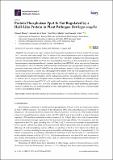Por favor, use este identificador para citar o enlazar a este item:
http://hdl.handle.net/10261/187942COMPARTIR / EXPORTAR:
 SHARE SHARE
 CORE
BASE CORE
BASE
|
|
| Visualizar otros formatos: MARC | Dublin Core | RDF | ORE | MODS | METS | DIDL | DATACITE | |

| Título: | Protein phosphatase Ppz1 is not regulated by a Hal3-like protein in plant pathogen Ustilago maydis |
Autor: | Zhang, Chunyi; Torre, Antonio de la CSIC; Pérez-Martín, José CSIC ORCID ; Ariño, Joaquín | Palabras clave: | Protein phosphorylation CoA biosynthesis Ustilago maydis Fungi Protein phosphatase |
Fecha de publicación: | 5-ago-2019 | Editor: | Multidisciplinary Digital Publishing Institute | Citación: | International Journal of Molecular Sciences 20(15): 3817 (2019) | Resumen: | Ppz enzymes are type-1 related Ser/Thr protein phosphatases that are restricted to fungi. In S. cerevisiae and other fungi, Ppz1 is involved in cation homeostasis and is regulated by two structurally-related inhibitory subunits, Hal3 and Vhs3, with Hal3 being the most physiologically relevant. Remarkably, Hal3 and Vhs3 have moonlighting properties, as they participate in an atypical heterotrimeric phosphopantothenoyl cysteine decarboxylase (PPCDC), a key enzyme for Coenzyme A biosynthesis. Here we identify and functionally characterize Ppz1 phosphatase (UmPpz1) and its presumed regulatory subunit (UmHal3) in the plant pathogen fungus Ustilago maydis. UmPpz1 is not an essential protein in U. maydis and, although possibly related to the cell wall integrity pathway, is not involved in monovalent cation homeostasis. The expression of UmPpz1 in S. cerevisiae Ppz1-deficient cells partially mimics the functions of the endogenous enzyme. In contrast to what was found in C. albicans and A. fumigatus, UmPpz1 is not a virulence determinant. UmHal3, an unusually large protein, is the only functional PPCDC in U. maydis and, therefore, an essential protein. However, when overexpressed in U. maydis or S. cerevisiae, UmHal3 does not reproduce Ppz1-inhibitory phenotypes. Indeed, UmHal3 does not inhibit UmPpz1 in vitro (although ScHal3 does). Therefore, UmHal3 might not be a moonlighting protein. | Descripción: | © 2019 by the authors. | Versión del editor: | https://doi.org/10.3390/ijms20153817 | URI: | http://hdl.handle.net/10261/187942 | DOI: | 10.3390/ijms20153817 | ISSN: | 1661-6596 | E-ISSN: | 1422-0067 |
| Aparece en las colecciones: | (IBFG) Artículos |
Ficheros en este ítem:
| Fichero | Descripción | Tamaño | Formato | |
|---|---|---|---|---|
| Zhang_Protein_Art2019.pdf | 4,06 MB | Adobe PDF |  Visualizar/Abrir |
CORE Recommender
PubMed Central
Citations
5
checked on 20-mar-2024
SCOPUSTM
Citations
5
checked on 15-abr-2024
WEB OF SCIENCETM
Citations
5
checked on 25-feb-2024
Page view(s)
217
checked on 19-abr-2024
Download(s)
173
checked on 19-abr-2024

